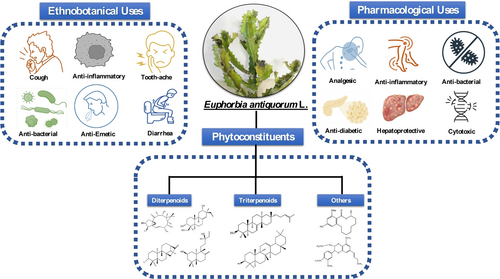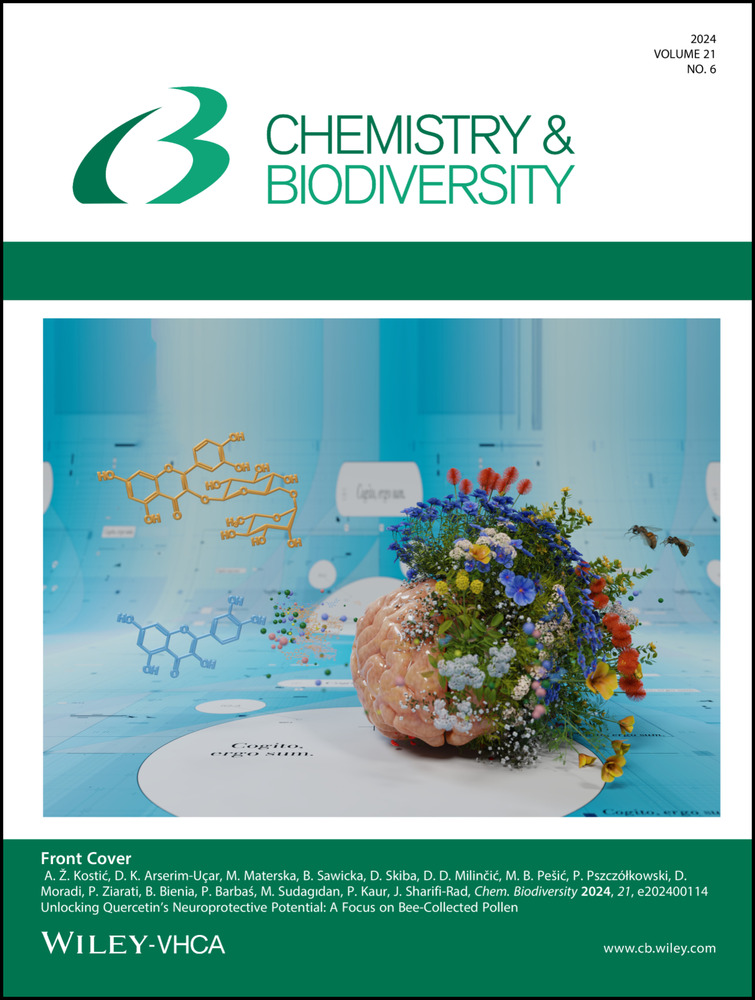A Review on Ethnobotany, Phytochemistry and Pharmacological Activities of Euphorbia antiquorum L.
Lunasmrita Saikia
Faculty of Pharmaceutical Science, Assam down town University, Panikhaiti, Guwahati, 781026 Assam, India
Search for more papers by this authorJyotirmoy Bhattacharyya
Faculty of Pharmaceutical Science, Assam down town University, Panikhaiti, Guwahati, 781026 Assam, India
Search for more papers by this authorSaikat Sen
Faculty of Pharmaceutical Science, Assam down town University, Panikhaiti, Guwahati, 781026 Assam, India
Search for more papers by this authorCorresponding Author
Partha Pratim Dutta
Faculty of Pharmaceutical Science, Assam down town University, Panikhaiti, Guwahati, 781026 Assam, India
Search for more papers by this authorLunasmrita Saikia
Faculty of Pharmaceutical Science, Assam down town University, Panikhaiti, Guwahati, 781026 Assam, India
Search for more papers by this authorJyotirmoy Bhattacharyya
Faculty of Pharmaceutical Science, Assam down town University, Panikhaiti, Guwahati, 781026 Assam, India
Search for more papers by this authorSaikat Sen
Faculty of Pharmaceutical Science, Assam down town University, Panikhaiti, Guwahati, 781026 Assam, India
Search for more papers by this authorCorresponding Author
Partha Pratim Dutta
Faculty of Pharmaceutical Science, Assam down town University, Panikhaiti, Guwahati, 781026 Assam, India
Search for more papers by this authorAbstract
Euphorbia antiquorum L. is a small plant in the Euphorbiaceae family that is found primarily in tropical and subtropical Asia. It has a long tradition of being utilized in Chinese, Ayurvedic, and other traditional systems for a variety of ailments. To date, More than 116 bioactive constituents were isolated from Euphorbia antiquorum, with diterpenoids being the most abundant. Extracts and isolated chemicals from various portions of the plant have demonstrated significant pharmacological activities such as anti-inflammatory, analgesic, antidiabetic, anticancer etc. It is necessary to conduct an in-depth investigation of the phytochemicals along with the pharmacological properties of E. antiquorum. This review summarised the knowledge of ethnobotany, phytochemistry and pharmacological activities of the plant which will provide a better understanding to clarify the traditional uses of the species and its relation to modern pharmacology which will ultimately pave the way for its clinical application.
Graphical Abstract
Conflict of interests
The authors declare no conflict of interest.
References
- 1P. K. Yadav, S. S. Sisodia, J. Drug Delivery Ther. 2019, 10, 39–44.
10.22270/jddt.v10i1-s.3871 Google Scholar
- 2P. K. Yadav, S. S. Sisodia, IJPSR 2020, 11, 916–921.
- 3A. S.R Anjaneyulu, K. J. Rao, L. R. Row, C. Subrahmanyam, Tetrahedron 1973, 29(10), 1291–1298.
- 4W. J. Yuan, W. F. Gao, J. Y. Zhao, Y. Zhang, D. Z. Chen, S. L. Li, Y.T Di, X.J Hao, Fitoterapia 2020, 144, 104583.
- 5C. L. Tran, T. B. N. Dao, T. N. Tran, D. T. Mai, N. M.A Tran, V. S. Dang, T. X. Vo, T. H. Duong, J. Sichaem, Mol. 2021, 26, 2257.
- 6S. Roy, R. Acharya, A. Ranade, M.S Cholera, Int. J. Pharm. Pharm. Sci. 2020, 12(2).
- 7N. Kar, V. Patil, World journal of pharmacuetical research 2023, 5, 1863–1875.
- 8S. Dey, A. Bag, S. Mukherji, Indian Biol. 1995, 27, 14–18.
- 9W. T. Hsieh, H. Y. Lin, H. J. Chen, W. C. Lin, Y. H. Kuo, W. G. Wood, H. F. Lu, J. G. Chung, Nutr. Cancer. 2011, 63, 1339–1347.
- 10B. Das, S. Alam, R. Bhattacharjee, B. K. Das, Am. J. Pharmacol. Toxicol 2015, 10, 46–55.
- 11V. Anjaneyulu, D. N. Rao, L. R. Row, J. Indian Chem. Soc. 1967, 44(2), 123–6.
- 12V. Madhavan, A. Murali, D. S. Lalitha, S. Yoganarasimhan, J. Intercult. Ethnopharmacol. 2015. 4(4), 308.
- 13C. Rajkuberan, S. Prabukumar, G. Sathishkumar, A. Wilson, K. Ravindran, S. Sivaramakrishnan, Arab. J. Chem. 2017, 21, 911–919.
- 14A. Kumara, D. L. Jayratne, G. V. Samaranayake, Int. j. appl. biol. pharm. 2017, 2(2) 15–17.
- 15B. Chowdary, M. S. Kumar, M. V. Krishna, M.J Mercy, Asian J. Pharm. Pharmacol 2020, 5, 1226–1229.
10.31024/ajpp.2019.5.6.20 Google Scholar
- 16Y. Prashant, S. Kritika, M. Anurag, IJPPR 2015, 4, 56–67.
- 17A. Kumar, D. Saikia, J Anal Pharm Res. 2016, 2(4), 00024.
- 18A. Lijun, Y. Liang, X. Yang, H. Wang, J. Zhang, M. Tuerhong, D. Li, C. Wang, D. Lee, J. Xu, L. Shuai, J. Jin, Y. Guo, Bioorg. Chem. 2019, 92, 103237.
- 19P. Deka, K. K. Nath, S. K. Borthakur, IJTK 2008, 7, 466–468.
- 20A. N. Harpalani, A.D Taranalli, O.V Kishor, R.V Karadi, R. V. Shete, Pharmacologyonline 2011, 2, 287–98.
- 21T. M. Jyothi, K. Prabhu, E. Jayachandran, S. Lakshminarasu, Pharmacogn. Mag. 2008, 127–133.
- 22A. Mishra, S. Parida, Plant Science Today 2023, 10(2), 61–73.
- 23S. Choodej, S. Hanthanong, T. Aree, K. Pudhom, Phytochemistry 2020, 180, 112523.
- 24L. A. Liang, Z. Shi, X. Zhang, C. Xie, M. Tuerhong, Z. Song, Y. Ohizumi, L. Dongho, L. Shuai, J. Xu, Y. Guo, J. Nat. Prod. 2019, 82, 16634–1644.
- 25M. B. Gewali, H. Masao, T. Yasuhiro, Y. Tohru, T. Namba, Chem. Pharm. Bull. 1989, 37, 1547–1549.
- 26T. Akihisa, E. M. K. Wijeratne, H. Tokuda, F. Enjo, M. Toriumi, Y. Kimura, K. Koike, T. Nikaido, Y. Tezuka, H. Nishino, J. Nat. Prod. 2002, 65, 158–62.
- 27H. Gotta, W. Adolf, H. J. Opferkuch, E. Hecker, Z. Naturforsch C. J. Biosci. 1984, 39, 683–694.
10.1515/znb-1984-0525 Google Scholar
- 28P. K. Sake, B. Rajeswari, R. L. Veeranjaneya, A. G. Damu, S. V. P. S. Khan, Indian J. Adv. Chem. Sci. 2013, 2, 117–122.
- 29V. Anjaneyulu, K. Ravi, Phytochem. 1989, 28, 1695–1697.
- 30W. Y. Qi, W. Y. Zhang, Y. Shen, Y. Leng, K. Gao, J.M Yue, J. Nat. Prod. 2014, 77, 1452–1458.
- 31M. Dong, X. Q. Chen, C. H. Chen, R. T. Li, Biodivers. 2018, 15, e1700560.
10.1002/cbdv.201700560 Google Scholar
- 32Z. Y. Yin, Y. Dai, P. Hua, Z. J. Sun, Y. F. Cheng, S. H. Yuan, Y. C. Zi, Q. Gu, Bioorg. Chem. 2019, 92, 103292.
- 33T. N. Tran, J. Sichaem, V. K. Nguyen, W. Chavasiri, N. Niamnont, J. Jongaramruong, T. H. Duong, Nat. Prod. Res. 2019, 35, 312–317.
- 34T. N. Tran, J. Sichaem, V.K Nguyen, H.H Nguyen, T. T. Cao, T. P. Nguyen, V. G. Vo, N. Niamnont, N. H. Nguyen, T. H. Duong, Nat. Prod. Res. 2022, 36, 523–530.
- 35M. Zhi-da, M. Mizuno, T. Tanaka, M. Iinuma, G. Y. Xu, H. Qing, Phytochemistry 1990, 29, 3952–3953.
- 36Y. Chen, X. Tian, Y. Li, G. Yang, Yaoxue Xuebao 2009, 44(10), 1118–1122.
- 37N. K. Kumari, M. V. Jagannadham, S. M. Rajendran, IN-2015KO00232, 2016.
- 38S. S. Yi, H. Miang, J. Liang, T. L. Xue, M. Zhida, Zhongguo Tianran Yaowu 2015, 3(1), 31–33.
- 39J. Siritapetawee, L. Wanwisa, W. Watchara, M. Janjira, S. Worada Int.J. Bio. Macromol. 2018, 120, 1846–1854.
- 40M. B. Gewali, H. Masao, T. Yasuhiro, Y. Tohru, T. Namba, Phytochemistry 1990, 29, 1625–1628.
- 41A. S. R. Anjaneyulu, K. J. Rao, L. R. Row, C. Subrahmanyam, Curr. Sci. 1973, 36(8), 204.
- 42M. Zhi-da, M. Mizuno, T. Tanaka, M. Iinuma, G. Y. Xu, H. Qing, Phytochemistry 1989, 29(2), 553.
- 43P. Sengupta, S. Ghosh, Indian J. Chem. 1964, 2(7), 298 .
- 44Z. Li, J. Yan, Y. Wang, L. Zhang, L. Li, Yunnan Minzu Daxue Xuebao, Ziran Kexueban, 2006, 15(4), 313–314.
- 45V. Anjaneyulu, D. N. Rao, L. R. Row, Curr. Sci. 1964, 33(19), 583–4.
- 46Y. Li, X. Tian, G. Yang, Y. Chen, Huazhong Shifan Daxue Xuebao, Ziran Kexueban, 2008, 42(3), 396–399.
- 47J. Hu, H. Li, X. Mao, Chem. Nat. Compd. 2016, 52, 48–51.
- 48Z. Zhang, CN-104288589, 2015.
- 49J. Xu, Y. Guo, Y. Liang, Z. Shi, L. An, CN- 111777512, 2020.
- 50Y. Guo, J. Xu, Y. Liang, Z. Shi, L. An, CN-111454153, 2020.
- 51T. V. V. S. R. Varma, IN-2015CH01837, 2016.
- 52Z. Ning, S. Xu, Z. Qiang, H. Shi, CN-102908521, 2013.
- 53C. Gong, CN-105327177, 2016.
- 54H. Liang, CN-105663933, 2016.
- 55X. Chen, CN-106806755, 2017.
- 56Z. Qu, X. Li, D. Ding, R. Liang, CN-111265604,2020.
- 57R. Lin, CN-111514223, 2020.
- 58P. Li, J. Li, G.Wang, R. Bai, S. Duan, L. Zhu, Q. Zhang, J. Gao, Y. Yin, R. Sun, CN-102397279, 2012.
- 59D.Y Youmbi, P. Eke, L. R. K. Kouokap, V. N. Dinango, Tamghe, L. N. Wakam, F. F. Boyom, Egyptian Journal of Biological Pest Control. 2022, 32(1), 77.
10.1186/s41938-022-00575-x Google Scholar
- 60J. Xue, X. Zong, Z. Feng, H. Yang. J. Chu, CN- 104815224, 2015.
- 61S. Li, CN-105232696, 2016.
- 62N. Qi, CN-105250474, 2016.
- 63T. Zhang, CN-105560776, 2016.
- 64C. H. Lin, W. C. Cheng, U. S.– 20030165579, 2003.
- 65P. K. Yadav, S. S. Sisodia, J. Drug Delivery Ther. 2019, 10, 39–44.
10.22270/jddt.v10i1-s.3871 Google Scholar
- 66W. T. Hsieh, H. Y. Lin, H. J. Chen, W. C. Lin, Y. H. Kuo, W. G. Wood, H. F. Lu, J. G. Chung, Environ. Toxicol. 2015, 30, 1205–1215.
- 67R. Li, D. Liu, T. Yang, X. Chen, H. Li, J. Zhong, R. Ye, S. Yan, M. Dong, CN-108992439, 2018.
- 68Q. Gu, Y. Cheng, Z. Yin, J. Xu, CN-110563679, 2019.
- 69Y. Ma, W. Yang, H. Guo, CN-113509473, 2021.
- 70V. Bharathi, M. Das, S. Afr. J. Bot. 2022, 151, 410–416.
- 71D. W. A. P. P. Silva, G. K. Manuweera, S. H. P. P. Karunaratne, J. Natl. Sci. Found. 2008, 36(1).
- 72T. Tran, S. Nguyen, H. Huyuh, Trop. J. Nat. Prod. Res. 2022, 6(7), 1140–1145.
- 73J. B. Vimal, S. S. M. Das, J. Entomol. Zool. Stud. 2014, 2, 267–269.
- 74V. S. S. Kantamreddi, G. K. Raju, Int. J. Chem. Sci. 2018, 16(1), 250–256.
- 75T. M. Jyothi, K. Prabhu, E. Jayachandran, S. Lakshminarasu, S. S. Ramachandra, Pharmacogn. Mag. 2008, 127–133.
- 76Y. Zhu,. CN-103341009, 2013.
- 77P. Zhang, CN-105497793, 2016.
- 78Z. Gao, CN-104666783, 2015.
- 79J. C. Gamadia, IN- 202021016816, 2020.
- 80J. Wang, CN-1813799, 2006.
- 81M. Lv, L. Yan, T. Tang, CN-102940869, 2013.
- 82H. Li, CN-105617076, 2016.
- 83X. Chen, CN-105395886, 2016.
- 84X. Chen, CN-105362599, 2016; X. Chen, CN-105362684, 2016.
- 85Y. Shi, CN-106031506, 2016.
- 86F. Meng, Y. Zhu, CN-105617107, 2016.
- 87P. Pushpangadan, V. George, A. K. Chauhan, A. Chauhan, A. Chauhan, A. Chauhan, A. Chauhan, Indian Pat. Appl. 2010, IN 2008DE02634 A 20100528.
- 88F. Yin, S. Wang, CN-106421012, 2017.
- 89A. P. Urs, V. N. Manjuprasanna, G. V. Rudresha, V. Hiremath, V. B. S. Sharana, Biochimica et Biophysica Acta (BBA)-Molecular Cell Research 2021, 1868(3), 118925.
- 90F. Yin, S. Wang, CN-106434191, 2017.
- 91B. Man, S. Li, H. Man, F. Man, CN-102218131, 2011.
- 92Q. He, CN-105998549, 2016.
- 93C. Zhu, CN-105641325, 2016.
- 94G. Sun, H. Wang, G. Tan, M. Diao, L. Tian, Q. Liu, CN-107890535, 2018.
- 95D. Li, CN- 104666663, 2015.





